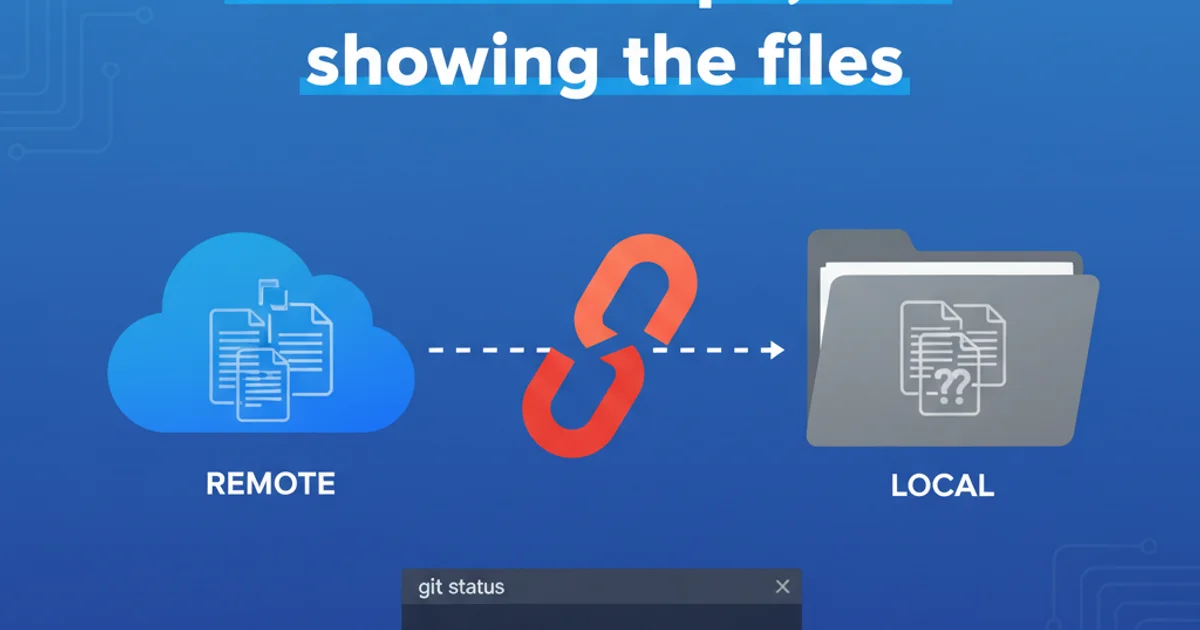Git remote repo, not showing the files
Categories:
Troubleshooting: Git Remote Repository Not Showing Files

Discover why your Git remote repository might appear empty or not show expected files, and learn practical steps to diagnose and resolve these common issues.
It's a common and often frustrating scenario: you've pushed changes to your remote Git repository, but when you check the remote (e.g., on GitHub, GitLab, Bitbucket), the files you expect to see are nowhere to be found. This can lead to confusion, especially for new Git users. This article will guide you through the typical reasons why this happens and provide clear, actionable steps to troubleshoot and fix the problem, ensuring your remote repository accurately reflects your local work.
Understanding the Git Workflow
Before diving into troubleshooting, it's crucial to understand the fundamental Git workflow. Files move from your working directory to the staging area, then to your local repository (via a commit), and finally to the remote repository (via a push). Any break in this chain can result in files not appearing remotely.
flowchart TD
A[Working Directory] --> B[Staging Area]
B --> C[Local Repository (Commit)]
C --> D[Remote Repository (Push)]
D -- X Not Showing --> E[Troubleshoot]
E --> F[Verify Local State]
E --> G[Check Remote Branch]
E --> H[Inspect .gitignore]Simplified Git Workflow and Potential Failure Point
Common Causes and Solutions
Several factors can contribute to files not appearing on your remote. We'll explore the most frequent culprits and how to address them.
1. Uncommitted or Unpushed Changes
The most common reason files don't appear remotely is that they haven't been properly committed to your local repository or pushed to the remote. Git requires explicit commands for each step.
1. Verify Local Status
Use git status to see if your files are staged, unstaged, or untracked. Untracked files are not yet part of your Git repository.
2. Add Files to Staging
If files are untracked or modified, add them to the staging area using git add . (for all changes) or git add <filename>.
3. Commit Changes
Commit your staged changes to your local repository with git commit -m "Your commit message".
4. Push to Remote
Finally, push your local commits to the remote repository using git push origin <branch-name>. Replace <branch-name> with your actual branch (e.g., main or master).
git status
git add .
git commit -m "Add initial project files"
git push origin main
Standard Git commands to add, commit, and push changes.
2. Incorrect Branch or Remote
You might be pushing to a different branch than you're checking on the remote, or even to an entirely different remote repository. This is especially common when working with multiple branches or forks.
1. Check Current Branch
Use git branch to see your current local branch. The active branch will be highlighted.
2. Check Remote Configuration
Use git remote -v to list all configured remotes and their URLs. Ensure you are pushing to the correct remote.
3. Verify Remote Branch
When pushing, ensure you specify the correct remote branch. For example, git push origin feature/new-feature will push to the feature/new-feature branch on the origin remote.
git branch
git remote -v
git push origin develop
Commands to inspect current branch and remote configurations.
3. Files Ignored by .gitignore
If your files are present locally but never even show up as 'untracked' in git status, they might be listed in your .gitignore file. Git will intentionally ignore any files or directories specified in this file, preventing them from being added to the repository.
1. Inspect .gitignore
Open the .gitignore file in your project's root directory. Look for patterns that match the missing files or their containing directories.
2. Remove or Modify Entries
If you find an entry that's incorrectly ignoring your files, remove or modify it. For example, if *.log is ignoring a crucial app.log file, you might change it to temp/*.log if only temporary logs should be ignored.
3. Force Add (Use with Caution)
If a file was previously ignored and you now want to track it, you might need to force add it: git add -f <filename>. Then commit and push as usual.
# Example .gitignore content
node_modules/
*.log
# To force add a file that was ignored
git add -f my_important.log
git commit -m "Track important log file"
git push origin main
Example of .gitignore content and how to force add an ignored file.
.gitignore or using git add -f. Ensure you're not accidentally committing sensitive information or large, unnecessary files.4. Shallow Clones or Sparse Checkouts
While less common for this specific issue, if you or a collaborator performed a shallow clone (git clone --depth 1) or a sparse checkout, the local repository might not contain the full history or all files, which could lead to confusion about what should be pushed.
If you suspect this, consider performing a full clone or adjusting your sparse checkout configuration. For most users, this won't be the primary cause of missing files.